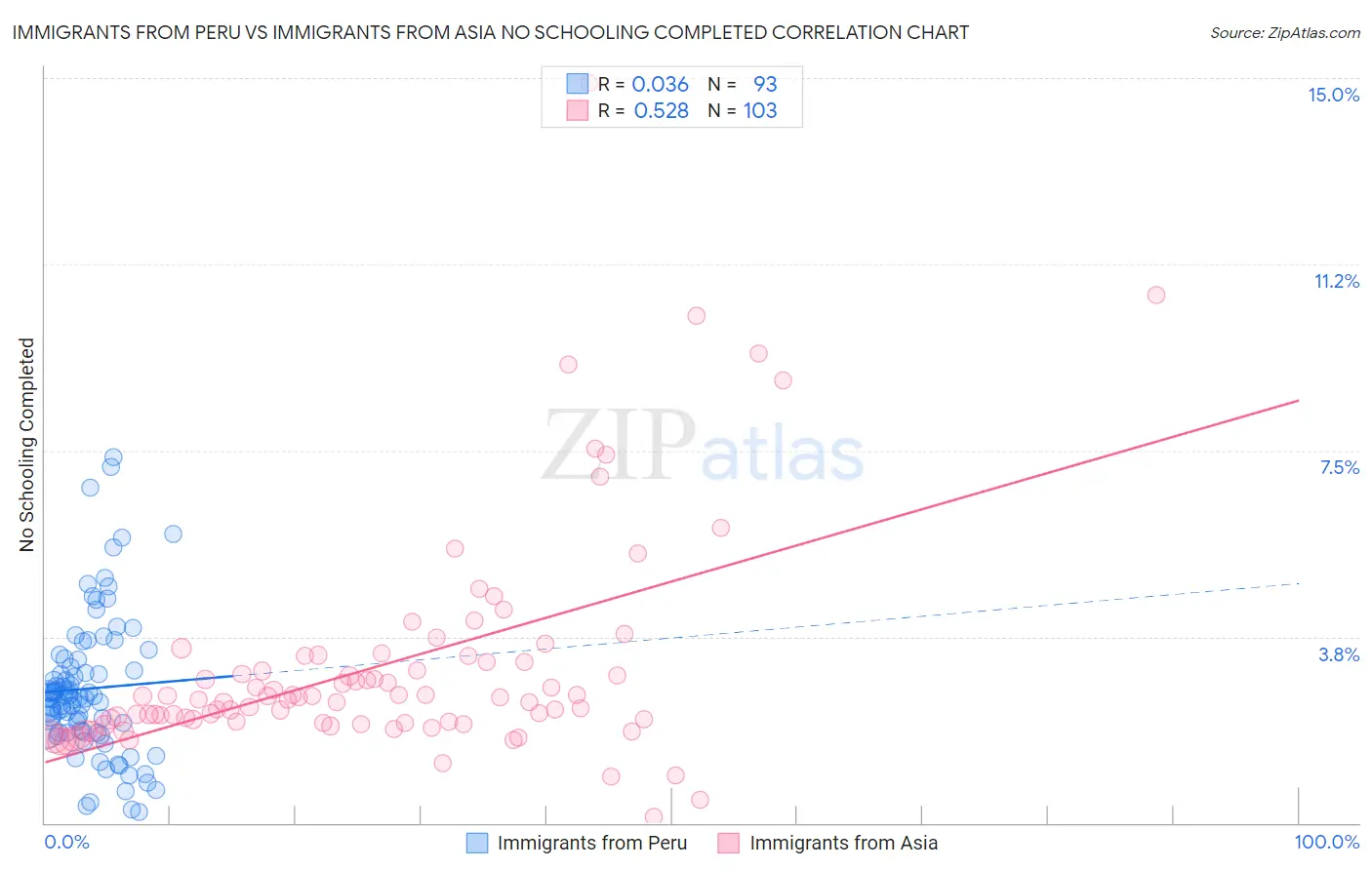Immigrants from Peru vs Immigrants from Asia No Schooling Completed
COMPARE
Immigrants from Peru
Immigrants from Asia
No Schooling Completed
No Schooling Completed Comparison
Immigrants from Peru
Immigrants from Asia
2.5%
NO SCHOOLING COMPLETED
0.2/ 100
METRIC RATING
270th/ 347
METRIC RANK
2.4%
NO SCHOOLING COMPLETED
0.9/ 100
METRIC RATING
253rd/ 347
METRIC RANK
Immigrants from Peru vs Immigrants from Asia No Schooling Completed Correlation Chart
The statistical analysis conducted on geographies consisting of 326,728,485 people shows no correlation between the proportion of Immigrants from Peru and percentage of population with no schooling in the United States with a correlation coefficient (R) of 0.036 and weighted average of 2.5%. Similarly, the statistical analysis conducted on geographies consisting of 536,190,509 people shows a substantial positive correlation between the proportion of Immigrants from Asia and percentage of population with no schooling in the United States with a correlation coefficient (R) of 0.528 and weighted average of 2.4%, a difference of 4.0%.

No Schooling Completed Correlation Summary
| Measurement | Immigrants from Peru | Immigrants from Asia |
| Minimum | 0.23% | 0.13% |
| Maximum | 7.4% | 14.9% |
| Range | 7.1% | 14.8% |
| Mean | 2.7% | 3.1% |
| Median | 2.5% | 2.5% |
| Interquartile 25% (IQ1) | 1.8% | 2.0% |
| Interquartile 75% (IQ3) | 3.3% | 3.2% |
| Interquartile Range (IQR) | 1.5% | 1.2% |
| Standard Deviation (Sample) | 1.4% | 2.3% |
| Standard Deviation (Population) | 1.4% | 2.3% |
Demographics Similar to Immigrants from Peru and Immigrants from Asia by No Schooling Completed
In terms of no schooling completed, the demographic groups most similar to Immigrants from Peru are Cuban (2.5%, a difference of 0.010%), Immigrants from Nigeria (2.5%, a difference of 0.080%), Taiwanese (2.5%, a difference of 0.94%), Yuman (2.5%, a difference of 1.2%), and Fijian (2.5%, a difference of 1.4%). Similarly, the demographic groups most similar to Immigrants from Asia are Immigrants from Colombia (2.4%, a difference of 0.13%), Immigrants from Eastern Africa (2.4%, a difference of 0.13%), Ethiopian (2.4%, a difference of 0.33%), Yaqui (2.4%, a difference of 0.50%), and Immigrants from Africa (2.4%, a difference of 0.57%).
| Demographics | Rating | Rank | No Schooling Completed |
| Immigrants | Africa | 1.1 /100 | #251 | Tragic 2.4% |
| Immigrants | Colombia | 1.0 /100 | #252 | Tragic 2.4% |
| Immigrants | Asia | 0.9 /100 | #253 | Tragic 2.4% |
| Immigrants | Eastern Africa | 0.9 /100 | #254 | Tragic 2.4% |
| Ethiopians | 0.8 /100 | #255 | Tragic 2.4% |
| Yaqui | 0.8 /100 | #256 | Tragic 2.4% |
| Immigrants | South America | 0.6 /100 | #257 | Tragic 2.5% |
| Assyrians/Chaldeans/Syriacs | 0.6 /100 | #258 | Tragic 2.5% |
| Immigrants | Jamaica | 0.6 /100 | #259 | Tragic 2.5% |
| Immigrants | Ethiopia | 0.6 /100 | #260 | Tragic 2.5% |
| Armenians | 0.5 /100 | #261 | Tragic 2.5% |
| Immigrants | Sierra Leone | 0.5 /100 | #262 | Tragic 2.5% |
| Immigrants | Liberia | 0.4 /100 | #263 | Tragic 2.5% |
| Indians (Asian) | 0.4 /100 | #264 | Tragic 2.5% |
| West Indians | 0.4 /100 | #265 | Tragic 2.5% |
| Fijians | 0.4 /100 | #266 | Tragic 2.5% |
| Yuman | 0.4 /100 | #267 | Tragic 2.5% |
| Taiwanese | 0.3 /100 | #268 | Tragic 2.5% |
| Immigrants | Nigeria | 0.2 /100 | #269 | Tragic 2.5% |
| Immigrants | Peru | 0.2 /100 | #270 | Tragic 2.5% |
| Cubans | 0.2 /100 | #271 | Tragic 2.5% |